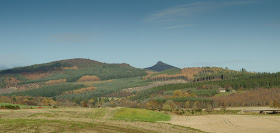The 28th December brought a calm day to the Moray Firth, perfect for a last paddle of 2018. Arriving at the tiny harbour at Sandend, I set out on my "usual" paddle, west around to Cullen. An ordinary sort of paddle to end the year I thought.
Straight away it was apparent that whilst the wind was light and the sea calm, it wasn't at all flat......
In fact there was a long-period groundswell from the north running at about a metre and around 11 seconds. Huge and powerful, mountains of water were roaring against the cliffs and rocks, giving lots of noise and excitement. There were channels and gaps which I'd usually paddle which were strictly out of bounds on this day as swell surged through.
Low winter sun over a calm sea, fantastic wildlife (over 20 species of birds plus seals today), rocky channels, sandy beaches, picturesque harbours, caves, arches and a ruined castle - an ordinary paddle? How could any day on this superb piece of coast be "ordinary"?!
Luncheon was taken in the shelter of Cullen harbour, mine were the only footprints today. I had a decision to make here, back to Sandend or across Cullen Bay to take in the Bow Fiddle Rock. Really it was an easy decision, I had plenty of time to take in the Bow Fiddle.
It all looks calm and serene in this image, but I waited for quite a while before committing to paddling out into the incoming swell. Having done that, I felt disinclined to go back through as swells ramped up and rolled through the arch. The nearby cave of the "Whale's Mou" was strictly off limits as the larger swells were closing the inner narrow end completely and bursting out into the shallow bay behind the cave.
I headed back, watching an interesting cloudscape form over the Moray hills as moist air was forced over higher ground.
After an uneventful paddle back and while winding down to finish at Sandend I completely failed to spot a very large swell behind me, rearing up over a submerged rock at Garron Point. The whole weight of the swell broke onto me and instantly capsized the boat. Quickly recovering, I shook the salt water off my face and drained my sinuses....an "ordinary" paddle my foot! On my last paddle of the year it was the sea which had the last word - which is quite fitting.
























































